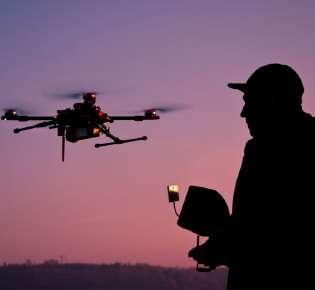
2 minute read
Drones and Journalism: How The Media is Makes Use of Aerial Vehicles “Drones”
In only a short period of years, unmanned aircraft systems (UAS), also called drones, have evolved from paparazzi gadgets to valuable tools helping journalists or global media in general to research, news-gather purpose, capture and share breaking news stories.
As many study the technological development and capabilities of contemporary drone hardware and the future of drone journalism. There’s consideration on the complex place of the media’s drone use in relation to international laws, as well as the ethical challenges and issues raised by the practice.
Advertisement
Consequently, many media organisations have been eager to explore the possibilities of drones. The technology is set to become a mainstream tool in journalism with vast potential applications, with the likes of not only using them for commercial operations, from agriculture to emergency operations but also as tools for creating visual art in photography, videography and journalism.
According to Federal Aviation Administration (FAA) which is the largest transportation agency of the U.S. government and regulates all aspects of civil aviation in the country as well as over surrounding international waters, operators are no longer required to obtain a pilot’s license before receiving an exemption to fly a drone. The easing of regulations was a significant development for photojournalism because it put relatively inexpensive aerial photography, videography and airborne sensors in the hands of journalists across the states. This has created vast opportunities as well as new challenges for journalists and regulators alike.
Advantages of Drone use are: Drones are unique as they offer distinct visual perspectives and can be used to explore new reporting frontiers, beyond the visuals, through data collection and integration with emerging technologies. The advantages of drone journalism are still emerging. And while there are critical regulatory and legal concerns still to be addressed, this is a field showing huge potential. UAS are delivering open-source aerial photography and disaster coverage to newsrooms across the country.
Drones are creating powerful storytelling moments, opportunities for multispectral imagery and photogrammetry. As a storytelling tool, it can take readers to new places and grant unexpected insights.
Cost-effectiveness is also a key advantage for reporters as events that are typically covered by news helicopters can often be transitioned to lower-cost UAS. Traditional methods such as renting a helicopter to get aerial images or video were only available to large media outlets due to price. The introduction of drones, have now become a saving grace for small operations because they can capture the same images and conduct the same investigations using a platform which is accessible and pays for itself almost immediately.
Drone journalism has the potential to cover natural or man-made disasters by illustrating the extent and gravity of the situation. Their visuals can also be used to create maps of disaster areas and, combined with data, explain how different communities fared after a major storm.
Challenges on Drone Use: Navigating the cumbersome regulatory framework

Operational safety risks and hazards.
Overcoming such challenges can is possible if Operational Intelligence (OI) platforms and applications can provide operators with real-time, in-depth data access in the most remote environments or low-bandwidth situations. Incorporating weather forecasts, maps and topography of the local area and other data, pre- and post-production planning native to OI applications for UAS can help journalists and film crews ensure ease and safety when filming.







